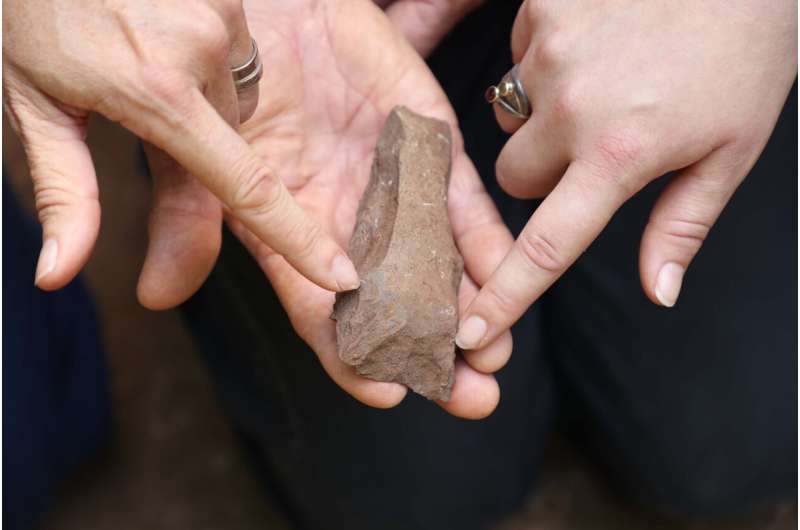Archaeological artifacts found on Norfolk Island

An archaeological dig on Norfolk Island has uncovered two Polynesian adzes (stone axes) and hundreds of flakes dating back to pre-European settlement.
The adzes were used for wood working and canoe building and form hard evidence of settlement on Norfolk Island by the Polynesians during the 13th and 15th CE.*
Part of the Australian Museum's first, broad scale, multi-pronged expedition of Norfolk Island, the first pieces of treasure were uncovered by local Norfolk Islander, Snowy Tavener, who had located the site on the walking track in Norfolk Island National Park more than four years ago.
It was identified as a new Polynesian site shortly after by Dr. Amy Mosig Way, a research archaeologist, and her Masters' student, Nicola Jorgensen, from the University's School of Humanities.
"For many years, I've been walking this track searching for evidence of a new Polynesian site on our island, so when I came across these flakes I couldn't believe my eyes," Snowy said.
"The track is an extremely popular bushwalking path and has been driven and walked over for hundreds of years, but before we told the wider community about our find, I wanted it confirmed by archaeologists."
"I showed the site to my friend, Deb Jorgensen, who has a daughter, Nicola Jorgensen, studying Archaeology at the University of Sydney under Dr. Amy Mosig Way from the Australian Museum, and the University of Sydney."
"Nicola was immediately interested and so she and her supervisor came over last year to confirm that it was indeed a potential new Polynesian site," he added.
Now completing her Masters' degree, Jorgensen said the flakes and adzes are made from basalt and are a tangible link back to the Polynesian heritage of Norfolk Island.
"The number of artifacts not only indicates the level of activity that occurred on the site, but also confirms that this is another site made by the original Polynesian ancestors, with the other first settlement site being located at Emily Bay," Jorgensen said.
Reflecting on the importance of the find, Jorgensen said it was exciting to her that this research commenced with local knowledge.
"I grew up here on beautiful Norfolk Island and like Snowy, feel proud to call it home. Local conservation efforts and preservation of our flora, fauna and historical sites can not only help advance scientific studies, but are also more likely to deliver positive outcomes for our community."
Dr. Mosig Way, a research archaeologist in a jointly held position at the University of Sydney and the Australian Museum, said the significance of the discovery is that it demonstrates the extent of the Polynesian settlement across the island.
"No longer can the idea of Polynesians inhabiting the island be thought of as fleeting," she said.
"The artifacts can provide us with an understanding of the behaviors, the possessions and the movement of the former Polynesian inhabitants of Norfolk Island. And what is particularly exciting is the preservation of the artifacts, despite the traffic that has occurred on this track during the last few hundred years."
Norfolk Island National Park Manager Nigel Greenup said that the discovery of the adze was significant.
"This discovery of an adze in Norfolk Island National Park indicates historical links with Polynesian people who first called Norfolk Island home—well before colonial settlement of the island."
"We will continue to work with the community and archaeologists to conserve this cultural heritage," he said.
Australian Museum Chief Scientist, Professor Kris Helgen, acknowledged that keen observations and persistence shown by Snowy has been the key to this extraordinary find.
"Incorporating local knowledge into our analyzing and collecting methods is integral to the Australian Museum's scientific research," Helgen said.
"I am impressed not only by Snowy's knowledge but also the enthusiasm and pride of the whole local community. I know we are all thrilled by these discoveries."
Supported by Norfolk Island National Park Manager Nigel Greenup, Jorgensen, Snowy and Dr. Mosig Way have carefully excavated, retrieved and recorded the items to ensure they are well-documented and conserved.
Once the dig is finished, the artifacts will be analyzed and cataloged by the scientists with the findings and acknowledgement of the local community to be included in a scientific paper. The artifacts will initially be stored on Norfolk Island while a process of community consultation is undertaken to seek views on the long-term preservation and display of the items.
Provided by University of Sydney





















